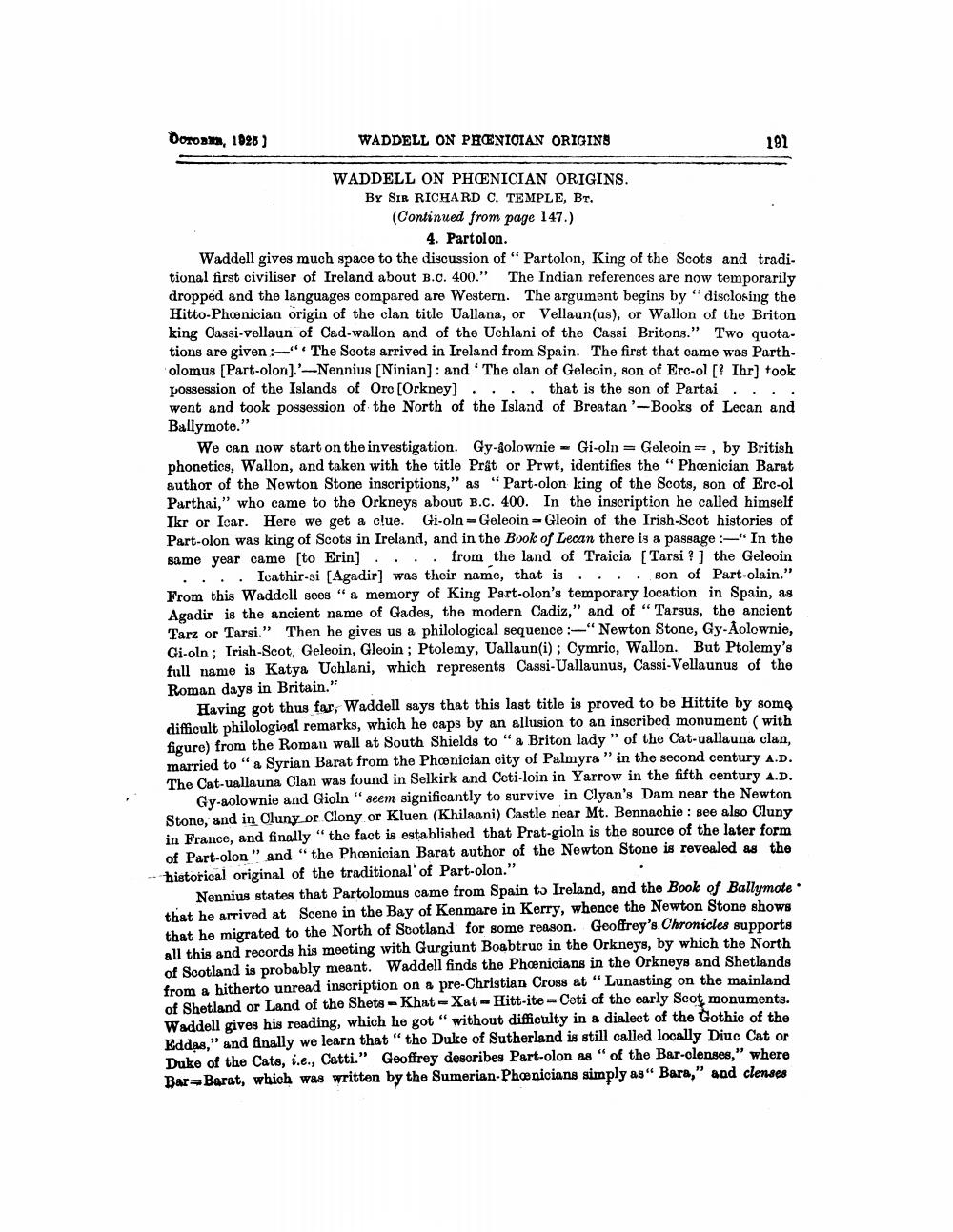________________
DoTOBER, 1925]
WADDELL ON PHOENICIAN ORIGINS
WADDELL ON PHOENICIAN ORIGINS. BY SIR RICHARD C. TEMPLE, BT. (Continued from page 147.)
4. Partolon.
191
Waddell gives much space to the discussion of "Partolon, King of the Scots and traditional first civiliser of Ireland about B.C. 400." The Indian references are now temporarily dropped and the languages compared are Western. The argument begins by "disclosing the Hitto-Phoenician origin of the clan title Uallana, or Vellaun(us), or Wallon of the Briton king Cassi-vellaun of Cad-wallon and of the Uchlani of the Cassi Britons." Two quotations are given :-"The Scots arrived in Ireland from Spain. The first that came was Partholomus [Part-olon].'-Nennius [Ninian]: and 'The clan of Gelecin, son of Erc-ol [? Ihr] took possession of the Islands of Orc [Orkney]. . . . that is the son of Partai went and took possession of the North of the Island of Breatan'-Books of Lecan and Ballymote."
We can now start on the investigation. Gy-ŝolownie Gi-oln Geleoin, by British phonetics, Wallon, and taken with the title Prat or Prwt, identifies the "Phoenician Barat author of the Newton Stone inscriptions," as "Part-olon king of the Scots, son of Erc-ol Parthai," who came to the Orkneys about B.C. 400. In the inscription he called himself Ikr or Icar. Here we get a clue. Gi-oln-Geleoin-Gleoin of the Irish-Scot histories of Part-olon was king of Scots in Ireland, and in the Book of Lecan there is a passage :-"In the same year came [to Erin] from the land of Traicia [Tarsi?] the Geleoin
.. Icathir-si [Agadir] was their name, that is... son of Part-olain." From this Waddell sees "a memory of King Part-olon's temporary location in Spain, as Agadir is the ancient name of Gades, the modern Cadiz," and of "Tarsus, the ancient Tarz or Tarsi." Then he gives us a philological sequence:-"Newton Stone, Gy-Aolownie, Gi-oln; Irish-Scot, Geleoin, Gleoin; Ptolemy, Uallaun(i); Cymric, Wallon. But Ptolemy's full name is Katya Uchlani, which represents Cassi-Uallaunus, Cassi-Vellaunus of the Roman days in Britain."
Having got thus far, Waddell says that this last title is proved to be Hittite by some difficult philological remarks, which he caps by an allusion to an inscribed monument (with figure) from the Roman wall at South Shields to "a Briton lady" of the Cat-uallauna clan, married to "a Syrian Barat from the Phoenician city of Palmyra " in the second century A.D. The Cat-uallauna Clan was found in Selkirk and Ceti-loin in Yarrow in the fifth century A.D. Gy-aolownie and Gioln "seem significantly to survive in Clyan's Dam near the Newton Stone, and in Cluny or Clony or Kluen (Khilaani) Castle near Mt. Bennachie: see also Cluny in France, and finally "the fact is established that Prat-gioln is the source of the later form of Part-olon" and "the Phoenician Barat author of the Newton Stone is revealed as the historical original of the traditional' of Part-olon."
Nennius states that Partolomus came from Spain to Ireland, and the Book of Ballymote⚫ that he arrived at Scene in the Bay of Kenmare in Kerry, whence the Newton Stone shows that he migrated to the North of Scotland for some reason. Geoffrey's Chronicles supports all this and records his meeting with Gurgiunt Boabtruc in the Orkneys, by which the North of Scotland is probably meant. Waddell finds the Phoenicians in the Orkneys and Shetlands from a hitherto unread inscription on a pre-Christian Cross at "Lunasting on the mainland of Shetland or Land of the Shets- Khat-Xat- Hitt-ite Ceti of the early Scot, monuments. Waddell gives his reading, which he got "without difficulty in a dialect of the Gothic of the Eddas," and finally we learn that "the Duke of Sutherland is still called locally Diuc Cat or Duke of the Cats, i.e., Catti." Geoffrey desoribes Part-olon as "of the Bar-olenses," where Bar-Barat, which was written by the Sumerian-Phoenicians simply as" Bara," and clenses




